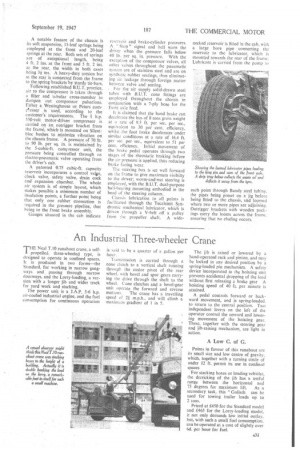An industrial Three-wheeler Crane
Page 33

If you've noticed an error in this article please click here to report it so we can fix it.
HE Neal T.10 runabout crane, a self
propelled, three-wheeled type, is designed to operate in confined spaces. It is produced in two forms—the Standard, for working in narrow gangways and passing through narrow doorways, and the Lorry-loading, a version with a longer jib and wider track for yard work and stacking.
The power unit is a LAP. 5-6 h.p. air-cooled industrial engine, and the fuel consumption for continuous operation
is said to be a quarter of a gallon per hour.
Transmission is carried through a cone clutch to a vertical shaft running through the castor pivot of the rear wheel, with bevel and spur gears carrying the drive through the shaft to the wheel. Cone clutches and a bevel-gear unit operate the forward and reverse
motions. The crane has a travelling speed of 24 .m.p.h., and will climb a maximum gradient of 1 in 5.
The jib is raised or lowered by a hand-operated rack and pinion, and may be locked in any desired position by a spring-loaded pin mechanism. A safety device incorporated in the hoisting unit prevents accidental dropping of the load without first releasing a brake gear A hoisting speed of 40 ft. per minute is attained.
A pedal controls forward or backward movement, and is spring-loaded. to return to the central position. Two independent levers on the left of the operator control the upward and lowering movement of the hoisting gear. These, together with the steering gear and jib-raising mechanism, are light in action.
A Low C. of G.
Points in favour of this runabout are its small size and low centre of gravity, which, together with a turning circle of under 12 ft. permit its use in confined spaces For stacking boxes or loading vehicles, the derricking of the jib has a useful range between the horizontal and 75 degrees fin maximum lift. As a secondary task. this "Goliath can be used for towing trailer loads up to 2 tons.
Priced at £450 for the Standard model and £465 for the Lorry-loading model, it not only demands low initial 'outlay, but, with such a small fuel consumption, can be operated at a cost of slightly over (id. per hour for fuel.












































































